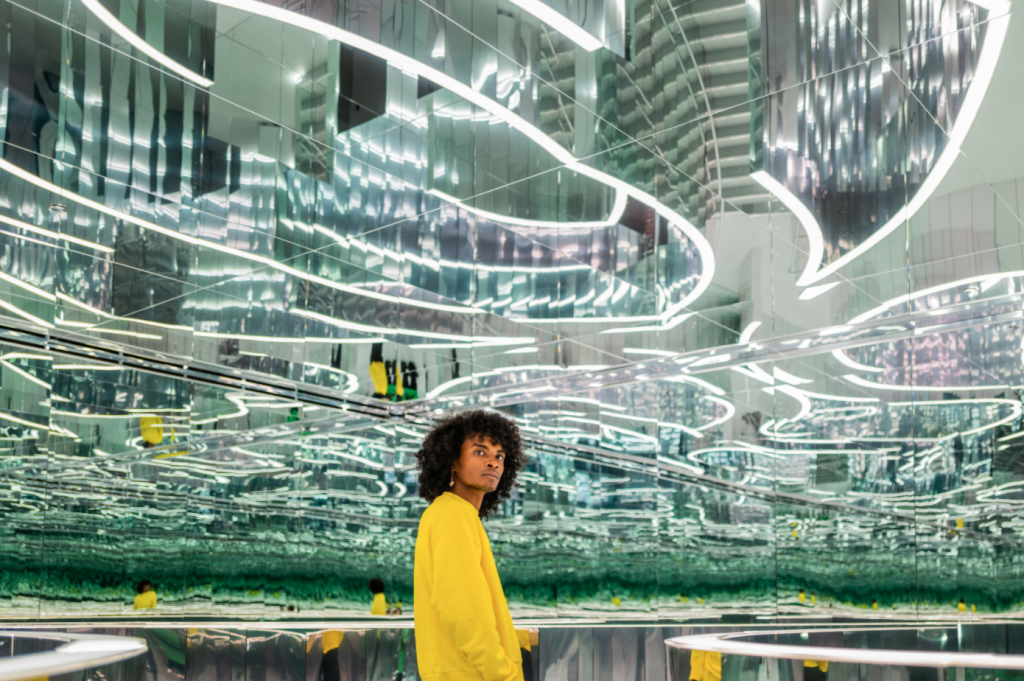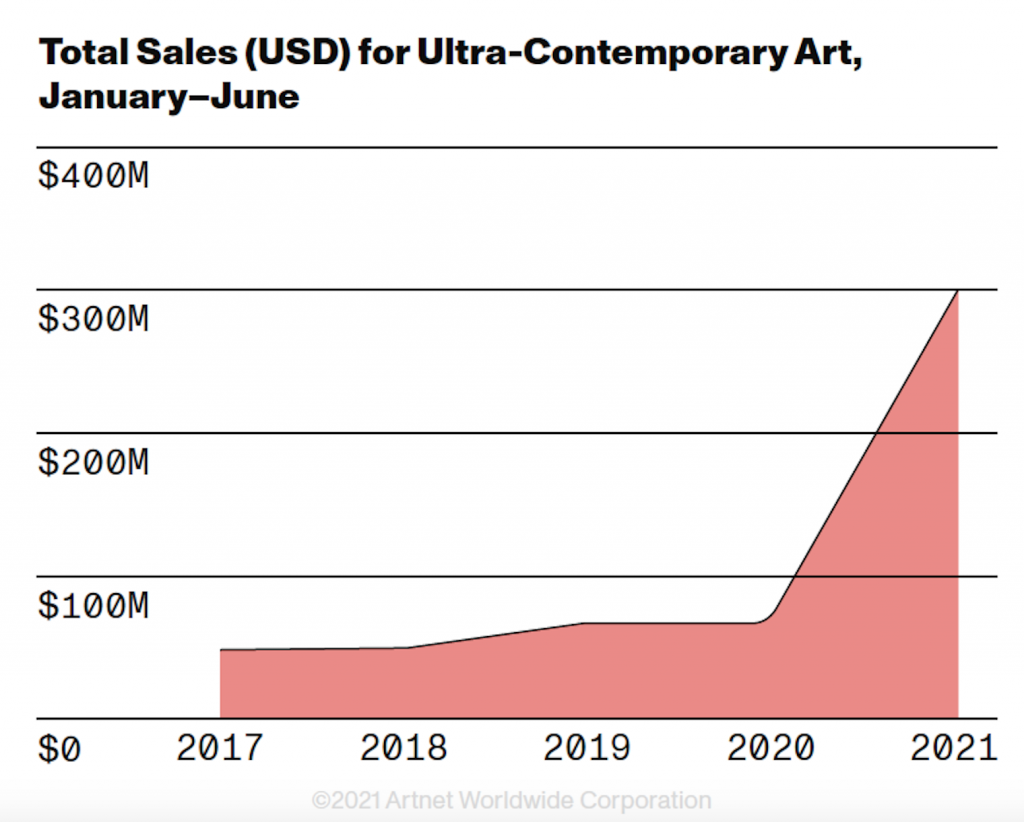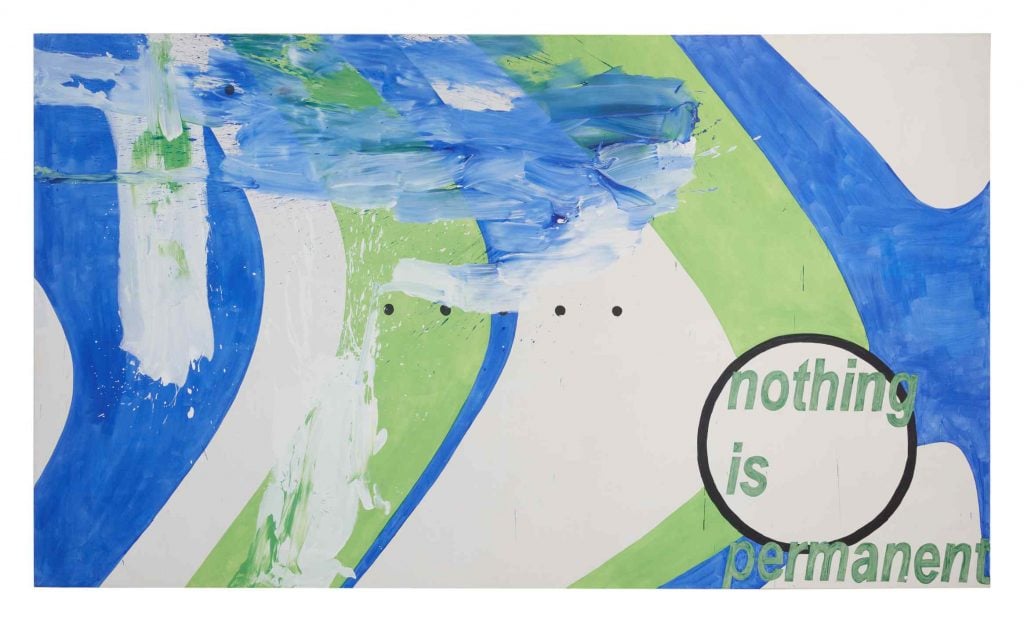The Back Room
The Back Room: Turn and Face the Change
This week in the Back Room: the next generation of art institutions, ultra-contemporary lots outsprint the field, mega-galleries chase crypto cool, and much more.

This week in the Back Room: the next generation of art institutions, ultra-contemporary lots outsprint the field, mega-galleries chase crypto cool, and much more.

Every Friday, Artnet News Pro members get exclusive access to the Back Room, our lively recap funneling only the week’s must-know intel into a nimble read you’ll actually enjoy.
This week in the Back Room: the next generation of art institutions, ultra-contemporary lots outsprint the field, mega-galleries chase crypto cool, and much more—all in an 8-minute read (2,188 words).
_________________________________________________________________________________________

Es Devlin, Forest of Us, (2021). Installation view of Every Wall is a Door, Superblue Miami, 2021. Photo: Andrea Mora.
Contrary to lockdown-era fears, steady streams of eager visitors have now proven that people still want to mass together (indoors, even!) at cultural destinations in the “new normal.” But more and more of the cultural destinations they’re flocking to have left behind the traditional model of the nonprofit exhibition space.
Simon de Pury, our Renaissance man about town, devoted his latest column to surveying the increasingly diverse landscape of alternative concepts for cultural institutions. While each business is unique, I think we can sort his main examples into three categories that will help us make sense of this ongoing metamorphosis beyond just the present moment.
1. The Immersive Exhibition-Maker
Structure: For Profit
Strategy: Sell tickets to experiential shows that hit the same 21st century pleasure centers as “Instagram traps” like the Museum of Ice Cream, only with grown-up multimedia artworks.
Proliferation Plans: Permanent Locations and Pop-ups
Example Institution: Superblue
A separate business that nonetheless shares key personnel with Pace Gallery, Superblue opened its first permanent space in Miami’s Allapattah district in 2021 with a trio of big-budget immersive installations. The business boasts private funding from Laurene Powell Jobs’s Emerson Collective, the Therme Art Group (Simon is a board member), and others, but aims to generate much of its revenue by selling timed tickets to the general public at scale—with a percentage of proceeds going to the artists involved.
Like other Immersive Exhibition-Makers, Superblue has telegraphed plans to multiply in both permanent and temporary forms. It recently launched a ticketed New York pop-up installation at the Shed, and will open a London pop-up later this month.
Exhibits Artists Like: teamLab, James Turrell, DRIFT
Unique Wrinkle: Superblue also develops public and private commissions that remunerate artists in various ways. (Read all about it here.)
Peers: teamLab isn’t just a Superblue artist; the collective also operates its own highly successful for-profit museums (plural) and temporary installations across multiple continents.
2. The Cultural Blender
Structure: For Profit
Strategy: Mix mainstream-friendly contemporary art exhibitions, event programming, and a lively bar/restaurant scene into a self-sustaining cultural lifestyle cocktail for the social-media age.
Proliferation Plans: Permanent Locations
Example Institution: The Moco Museum
Founded by dealers Lionel and Kim Logchies-Prins in 2016, Moco is a non-collecting institution that aims to build serious (yet not stuffy) shows around artists with strong pop-cultural appeal… but not necessarily deep art-world roots. Its flagship in Amsterdam attracts 650,000 annual attendees. Simon relays that a “very high” percentage of those attendees are young people—“most of whom have never been to a museum before”—and that ticket sales and merch “have entirely financed the operation.”
Moco’s revenue streams also include hosting private events such as catered dinners, “walking dinners,” and cocktail tours. The approach has proven lucrative enough to bankroll the freshly opened Moco Barcelona, as well as to trigger a slew of offers to launch more Mocos globally.
Exhibits Artists Like: Jean-Michel Basquiat, Beeple, KAWS
Peers: The photography-focused Fotografiska, founded in Stockholm in 2010, wrote the recipe by becoming “a favorite venue for weddings and birthday parties, as well as providing a fully equipped crèche and a nonstop program of lectures, symposia, and films,” Simon writes. Fotografiska has since expanded to New York and Tallinn; Berlin, Miami, and Shanghai are up next, thanks in part to its recent merger with NeueHouse.
3. The Cultural Laboratory
Structure: Nonprofit
Strategy: To produce mind-expanding cross-disciplinary shows and cultural projects that advance solutions to civilization-level injustices like the climate crisis, education, and human rights.
Proliferation Plans: TBD
Example: Luma Arles
Established by Maja Hoffman, who Simon calls “possibly the greatest living cultural philanthropist globally,” the larger Luma Foundation developed this multi-building, starchitect-designed campus to be a “constantly evolving work in progress where artists and scientists come together to address some of the vast issues we face as humanity.”
By orienting itself around making a society-shifting impact, not generating sustainable revenue or boosting visitors’ online clout and social-life prospects, Luma Arles doesn’t just aim higher than other alternative institutions. It arguably aims higher than traditional museums too—and its founder seems willing, able, and likely to keep sacrificing colossal capital in pursuit of its grander payoff.
Exhibits Artists Like: John Akomfrah, Ian Cheng, Pierre Huyghe
Peers: None (Yet).
_________________________________________________________________________________________
While it is often treated as a sacred cow nearly as old as history itself, the default Western model of an art museum—a quiet, pristinely lit white cube exhibiting a sparse subset of works curated from a larger permanent collection—has actually existed for less than 100 years. So we should not be shocked that more and more new branches are sprouting from the much older oak tree of visual culture, and the nascent art institutions Simon highlights suggest there can and will be more surprising new growth to come.
_________________________________________________________________________________________
The latest Wet Paint leads off with an insider’s breakdown of the 254 confirmed exhibitors at the upcoming Art Basel Miami Beach—and some of the health regulations that will try to keep everyone COVID-free while hobnobbing.
Overall, the fair will be 15 exhibitors smaller than its long-ago 2019 edition. No surprise, the majority of the newly absent dealers are based in Europe and Asia (and predominantly run smaller spaces there). Ergo, more than half of the participating dealers operate a location in the Americas. Notable opt-outs include Carlos/Ishikawa, Lévy Gorvy, Marlborough, and Société.
But ABMB 2021 will welcome 43 newcomers, led by the bicoastal Jeffrey Deitch (yes, weird but true!), New York’s Housing, Los Angeles’s Nicodim Gallery, London’s Southard Reid, Rele Gallery of Lagos and L.A. (the outfit that represents rising market star Marcellina Akpojotor), and Mexico City’s Pequod.
Good news on the vaccine front, too: The fair will accept a more inclusive list of jabs than its Swiss counterpart. Sellers, shoppers, and even lowly journalists will be A-OK with proof they’ve gotten the needle(s) from Pfizer, Moderna, Johnson and Johnson, AstraZeneca, Sinopharm BIBP, and Sinovac-CoronaVac. But masks will indeed still be required for entry.
Here’s what else made a mark around the industry since last Friday morning…
Art Fairs
Auction Houses
Galleries
Institutions
NFTs and More
_________________________________________________________________________________________

This week, my colleague Julia Halperin noted another big win for newness: Ultra-contemporary art has been the fastest-growing genre in the auction market this year, according to the latest Artnet Intelligence Report. (We define the category as work made by artists born after 1974.)
From January through June 2021, sales of ultra-contemporary work spiked to $302.6 million—almost 300 percent above their most recent peak, in 2019. “Remarkably,” Julia writes, “the size of the market for ultra-contemporary art now rivals that for Old Masters, which tallied $338.2 million worth of sales in the year’s first half. (For perspective: the former genre covers art made over the course of fewer than 50 years; the latter, more than six centuries.)”
And with major auctions in Hong Kong this month and New York in November, prepare to see even more money showered onto the freshest faces and wettest paint the hammer has to offer.
_________________________________________________________________________________________
“He knows exactly what he needs to do, exactly how many paintings he needs to make. And it’s never in response to the market—which is very healthy, but a little frustrating for the collectors.”
—Pace Gallery president and CEO Marc Glimcher on the confidently in-control artist Adam Pendleton.
_________________________________________________________________________________________
The one-and-only Kenny Schachter seasoned his signature wrap-up of Art Basel and all things blockchain with the tasty rumors that Hauser and Wirth is gearing up to launch its own NFT marketplace—and Gagosian is “undergoing exploration of its own” regarding doing the same. (Artnet News Pro)
_________________________________________________________________________________________
Sotheby’s announced it has restructured its two major evening sales of art into a triad organized “on stylistic grounds rather than strictly by date”… but also roughly by date, apparently. They are: “The Modern” (late 19th–early 20th c.), “The Contemporary” (postwar–late 20th c.), and “The Now” (2000–present). (ARTnews)
_________________________________________________________________________________________
Masterworks, the ubiquitous fractional ownership platform for blue-chip art, became the latest tech unicorn thanks to a $110 million Series A round that valued the firm above $1 billion. Among the investors: collector and FLAG Art Foundation founder Glenn Fuhrman. (Artnet News)
_________________________________________________________________________________________
… And since Masterworks’s success has prompted multiple die-hards to message me about it this week, let’s re-up my spring 2021 deep dive into the company’s business model (featuring one collector steeped in finance portraying its market data as “extreme bullshit”). (Artnet News Pro)
_________________________________________________________________________________________

Michel Majerus, Nothing is permanent (2000). Courtesy of Sotheby’s.
_________________________________________________________________________________________
Estimate: $100,000 to $150,000
Sale Price: $600,800 at Sotheby’s Contemporary Curated
It won’t knock you out of your chair to hear that rapid-rising young artists were responsible for some of the most in-demand works featured in the latest edition of everyone’s favorite Artnet News Pro auction roundup, Hot Lots. (Try stage-whispering it like a line in a Broadway show: “Hot Lots!” Trust me, it’s addictive.) But members of older generations put up some sizzling numbers there too.
Among them was the late Luxembourg-born artist Michel Majerus, whose work is being embraced by the market ahead of a solo exhibition at the ICA Miami in 2022. Majerus, who died in a plane crash nearly 20 years ago, has had his auction record reset twice in the past quarter alone. The new apex was reached last week by the behemoth nothing is permanent, whose amalgam of abstraction, text, and poignancy brought a premium-inclusive $600,800, more than quadruple the high estimate for the 8.5-foot-tall and almost 15-foot-wide canvas.
The artist’s previous auction high of $554,147 was achieved three months ago at Sotheby’s London. Both record paintings were sold by a New York Charitable Family Trust, which sources say is an entity linked to Jerry Speyer, the real estate mogul and chairman emeritus of the Museum of Modern Art. Several Majerus canvases have sold privately at similar price points, according to art advisor Allan Schwartzman. “He is a significant artist, whose work was prescient, and if the market is catching up with that, such a correction is long overdue,” he said.
_________________________________________________________________________________________